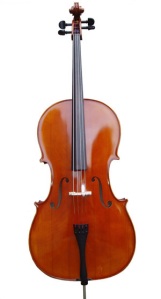

 What on earth are these pictures doing on a book blog? Welcome to Part Two of From Page to Stage, my version of the story of Queen Lear, a play by Eugene Stickland.
What on earth are these pictures doing on a book blog? Welcome to Part Two of From Page to Stage, my version of the story of Queen Lear, a play by Eugene Stickland.
That striking young woman at the top left is Hanna Stickland, professional name Johanna, and the picture comes from her pages on the Supermodels site. She has been on the runway in New York, London, Paris and Milan — and absolutely none of that is relevant here (but it is an impressive picture). As you have probably guessed, she is the daughter of playwright Eugene Stickland and it was her part-time job of “running lines” that started Queen Lear in motion.
The cello, upper right, is the third character in this three-character play. Eugene likes to think it is the cellist (someone to play the instrument is required, after all) but we theatre-lovers prefer to think of the cello as the real character. Instrument or performer, it (she) is on stage for the entire play and as important as the two speaking performers.
The mature woman in the armchair is Joyce Doolittle in her role as Jane, an actress in her 70s who is rehearsing to play Lear in the Women’s Theatre Collective, all-female version of King Lear. Joyce has been a part of the Calgary theatre community for more than 50 years. The Pumphouse Theatre (think of it as a Calgary version of Tate Modern, only about one one-hundreths as big — still, same brickwork, industrial memories, ideally suited for presenting modern art or drama) is in fact a former pumphouse and it has two theatres — the 70-seat house is called the Joyce Doolittle Theatre, so like Gielgud and Olivier, she has her claim to fame. (And the young actress in that picture is Georgina Beaty who played Heather, the character that Hanna inspired.)
Until a few weeks ago with the premiere of Queen Lear, Joyce had never performed in the theatre that bears her name. Were it not for Hanna (the running lines person, not the model) she might never have had the experience.
Playwright Stickland introduces it this way in the “Situation” for his play:
Jane was a well known actress in her day, but between a lack of roles for older women, and an increasing lack of confidence in her abilities — in particular, her memory — she has been in virtual retirement for several years.
Now she has been cast as Lear in an all female production of Shakespeare’s King Lear. Yet she fears for her memory and needs someone to run lines with her. She hires Heather, whom she knows because Heather’s father is an architect in the firm founded by Jane’s late husband.
Recreate the situation: Hanna Stickland has just found a “job” running lines with one of the city’s best-known actresses for $8 an hour. Her father drops her off and, as is his custom heads off for a coffee, notebook in hand. He muses about the experience and makes some notes — the creation of a wonderful play has begun.
Every city with a theatre community has its own version of Joyce Doolittle; someone who has been on stage for a very long time and done very good work, someone who still wants to work and someone who is getting frustrated, not by the loss of her own abilities, but by the lack of roles that are available to her. Those of us who are aging (male or female, and we don’t have to be actors) have some understanding. And the prospect of working with someone a couple of generations younger and perhaps influencing them has an appeal all its own. The way that Jane and Heather develop their relationship is magnificently done — no matter how cynical you might be, it is touching.
One of Eugene’s most daring tactics in this play is to cast Jane as Lear. It can be argued (comments and opinions are certainly welcome) that it is the most difficult of Shakespeare’s roles — if you are really good, you get to do Hamlet as a youngish actor, move on to the king in the Scottish play (its title will be avoided here) and then maybe close out professional life with Lear. Heck, even Christopher Plummer welcomed the chance. One of the interesting things about Queen Lear is that the actress who plays Jane in her 70s actually also has to play aspects of Lear, including the howling, howling, howling. Even the most experienced female actors have not been trained for that.
What about the third character, the cello? We will let the playwright intoduce her: “The Cellist is a creative spirit who can’t really be controlled, sometimes she gets in Jane’s way, sometimes she helps her.”
In fact, the play opens with an overture from the cello and the sound in Scene One consists only of cello music (Eugene suggests Bach’s Sonatas, which were in the Calgary production, but leaves the choice open to director and cellist). It is only a minor spoiler on my part (but if you really hate spoilers, skip the next paragraph or two) to reveal the role of the cello, as articulated by Jane:
I hardly know what’s coming out of my mouth. Just words. I open my mouth, words come out. Words I’ve read. Words I think I should be saying. But sometimes I reach for words but they’re not there, there are no words at all, they’re just gone, it’s all a blank page. And then all I hear is music, all that comes out is music…”
There ends my argument about whether the cello or the cellist is the third character.
As Jane and Heather run their lines (and there are some wonderful laughs as they do — Eugene writes serious themes under the guise of comedy), a fourth presence — as opposed to character — enters the play in the form of Heather’s deceased mother, an old friend and admirer of Jane’s. If you look around most theatre halls, the audience will be between 30 and 70 — so by definition, it would seem, this play with its two central characters excludes most of the audience.
Not so fast, and this is where I think Eugene has achieved something quite unusual. Those of us in the book-blogging world have been debating reliable narrators and unreliable narrators recently — Stickland has created the absent narrator (although, of course, that is the playwright). As the play develops both Jane and Heather “use” the deceased mother — as an audience we are very aware that we are sitting in exactly that role. The fourth character is in the house seats. We all have older role models, like Joyce, who are perhaps (only perhaps) approaching the end of their careers. We all have younger friends, like Heather, who we hope to influence for the best. I can’t remember another play that so completely engaged its audience as a member of the cast.
Okay. Major conflict of interest admission: I’ve already said Eugene is a close friend and so is Hanna. The premiere production of Queen Lear was done by Urban Curvz Theatre in Calgary, a company that my wife and I are proud to support, and we were producing sponsers of this production. It is a company founded on the premise that women too often get overlooked in the theatre community (not just on stage but back-stage as well) and devoted to creating opportunities for them. As is obvious, they aren’t super dogmatic about that — there is quite a good line in Queen Lear about the Women’s Theatre Collective being willing to overlook the fact that playwright Shakespeare was male.
That conflict involves no commercial interest on my part — Urban Curvz is a not-for-profit company and Eugene is an excellent example for theatre-lovers that the people who write the plays we love sacrifice a lot of normal human comfort to do that. A number of regular visitors to this blog are from the UK and I am sure at least one or two of them knows someone at the National Theatre — please, please could you get someone there to read this play. As a regular visitor to the Littleton, I can say this is exactly the kind of play that space was designed for. As I said earlier in this post, every community has a version of Joyce Doolittle — and. I am pretty sure that person would love to do this play.
Because few new plays get produced in books, buying a copy is actually quite hard. Log on to www.bhousepublications.com and send a message to the editor and they will be in touch. I don’t get over-enthusiastic often about literary work, but I can’t tell you how good I think this play is — if I haven’t conveyed that already.
 Mrs. KFC and I have always loved live theatre — there is a bin in the library where if you dig deep enough you will find a program from the original London production of Hair (and a few hundred other programs — Gielgud, Olivier and Dench are all well-represented, along with a host of Western Canadians that are probably unknown to most visitors to this blog).
Mrs. KFC and I have always loved live theatre — there is a bin in the library where if you dig deep enough you will find a program from the original London production of Hair (and a few hundred other programs — Gielgud, Olivier and Dench are all well-represented, along with a host of Western Canadians that are probably unknown to most visitors to this blog).